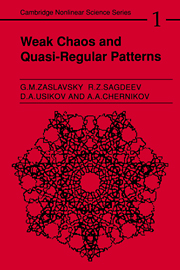Preface
Published online by Cambridge University Press: 29 October 2009
Summary
How does the onset of chaos in Hamiltonian systems occur? This is one of the key questions in the modern theory of dynamic systems. However narrowly specialist this question may seem, the answer has a bearing on almost every branch of physics, including the quantum theory.
Chaos emerges as a result of specific local instability with respect to arbitrarily small perturbations of the system's orbits. It manifests itself in certain regions of phase space and within a certain range of the system's parameters. But the most remarkable feature of chaos in the fact that it is irremovable in fairly general physical situations. What is meant is the following. Under fairly typical conditions in phase space and in the space of values of parameters there always exist such regions in which the dynamics of the system is stochastic. These regions may be arbitrarily small, nevertheless, for a certain structure of the dynamic system given by its Hamiltonian, they are irremovable at any finite values of parameters. An illuminating example of this situation is Arnold's diffusion – a universal, unlimited transport of particles along the channels of a stochastic web in systems with the number of degrees of freedom exceeding two.
As we transfer from systems totally free of stochastic dynamics to systems with chaos, we encounter small regions which are seeds of chaos. In Hamiltonian systems these are stochastic layers and stochastic webs which, being the manifestation of weak chaos in these systems, at the same time perform a certain partitioning of phase space.
- Type
- Chapter
- Information
- Weak Chaos and Quasi-Regular Patterns , pp. xi - xiiPublisher: Cambridge University PressPrint publication year: 1991



